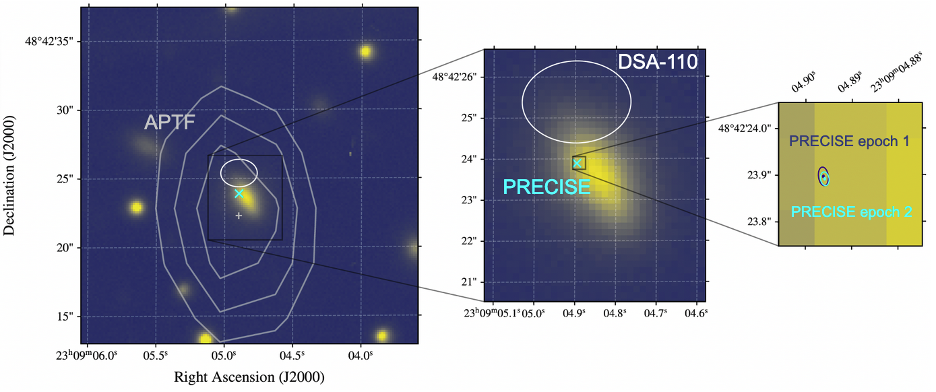
Milliarcsecond Localisation of the Hyperactive Repeating FRB 20220912A
Danté Hewitt
While most fast radio bursts (FRBs) are observed as one-off, millisecond-duration radio pulses originating from extragalactic distances, a small fraction (~3%) of these sources are known to repeat sporadically and infrequently and are called repeaters. In contrast to most repeaters, FRB 20220912A, discovered by The Canadian Hydrogen Intensity Mapping Experiment FRB project (CHIME/FRB), is extraordinarily active. During the peak of its activity, it contributed a few percent of the entire all-sky rate of FRBs above a fluence threshold of 100 Jy ms! As a result it has been targeted by various telescopes across the world, including an array of EVN (European VLBI Network) dishes used in EVN-Lite mode.
PRECISE (Pinpointing REpeating ChIme/frb Sources with EVN dishes; PI: Franz Kirsten) is an EVN-Lite project that makes use of ad-hoc arrays of radio dishes to localise repeating FRBs to the best-possible precision. PRECISE FRB localisations generally achieve astrometry on the order of milliarcseconds. Such localisations not only enable the identification of host galaxies of FRB sources, but also allow for their local environments to be studied in great detail using, e.g., the Hubble Space Telescope. In future, ground-based optical telescopes like the Extremely Large Telescope will be able to match the milliarcsecond resolution of VLBI, zooming in on the local environments of FRB sources at the (sub-)parsec level in their host galaxy, perhaps even revealing extragalactic stellar counterparts to FRB sources.

The background image is an R-band Keck II/ESI deep optical image (limiting magnitude R∼26) of the host galaxy of FRB 20220912A (Ravi et al. 2023). The grey plus-sign and contours (levels of 0.16, 0.20, and 0.24 mJy) indicate a catalogued radio continuum source, APTF J230904+484222 (Kutkin et al. 2022). The white ellipse shows the approximate 90% error ellipse of the DSA-110 localization of FRB 20220912A. The EVN position is indicated by the cyan cross, and the uncertainty is much smaller than the symbol size and the resolution of the optical image. The insets show consecutive zoom-ins on the EVN position of FRB 20220912A. In the right most inset, the synthesized beams of the EVN observations first epoch (45 bursts) and second epoch (105 bursts) are overplotted as dark blue and cyan ellipses, respectively. These ellipses are centred at the combined-burst positions.
In a recent study, PRECISE detected and localised 150 bursts from the hyperactive repeater FRB 20220912A, improving on previous localisations by a factor of a few hundred. The VLBI localisation showed that FRB 20220912A is situated closer to (yet still offset from) the center of its host galaxy, which was previously identified using the Deep Synoptic Array 110 (DSA-110) localisation. Compact persistent radio sources (PRSs) have been observed in some other active repeaters and are theorised to be hypernebulae powered by highly energetic neutron stars or accreting black holes. Interestingly, however, the PRECISE observations also ruled out the presence of a PRS at the FRB localisation, instead attributing the persistent radio emission seen on larger angular scales to star formation in the host galaxy. It’s unclear why this hyperactive repeater has no PRS counterpart whereas some apparently less active repeaters do.
References:
Ravi et al. 2023, ApJL, 949, L3
Kutkin et al., 2022, A&A, 667, A39
More information: Hewitt et al. 2024, MNRAS, 529, pp.1814-1826
Contact:
Danté Hewitt
Anton Pannekoek Institute for Astronomy, Amsterdam
Shivani Bhandari
ASTRON, JIVE, Dwingeloo, the Netherlands
Email: bhandari@astron.nl